The Lost Art of Patience: Waiting for a Letter to Arrive
- Handwritten Exchange

- Nov 6
- 3 min read

We live in a world of instant messages, overnight shipping, and constant notifications. Waiting can feel strange now. For most of history, though, patience was part of everyday communication. Letters moved by ship, train, and postal routes, and the time in between was simply expected.
There is something very human about anticipation. The quiet days between sending a letter and receiving one create room to think. That pause invites stillness. In a culture that rewards speed, this slower rhythm can feel like a relief.
The Beauty of Anticipation
Dropping a handwritten envelope in a mailbox means letting go of control. You do not know exactly when it will arrive or how the reader will feel when they open it. You cannot edit or pull it back. You send it, then you trust the process.
Days pass. Maybe weeks. Then a letter appears with your name written by another hand. You feel the paper, you open the seal, you begin to read. That moment often carries more weight than a quick notification on a screen.
Patience as a Form of Presence
Waiting can help you pay attention. It roots you in the present instead of the rush. People have relied on letters for centuries, and many famous correspondences unfolded over long stretches of time. Delays did not end those relationships, they often deepened them.
Those gaps give you space to live a little more before you respond. You think about what you will say. You choose words with care. The silence between letters shapes the next message.

Why Waiting Still Matters
Fast communication is useful, but speed can flatten the experience. When every message is instant, there is less room for reflection. Waiting for a letter is like taking a slow walk after a long run. It slows your thoughts and your expectations.
The delay adds meaning to the moment of arrival. When you finally open a letter, you do not just read information, you imagine the person who wrote it, the room they were in, and the time they set aside for you. That simple act can create a stronger sense of connection.
The Emotional Reward
Finding a letter in your mailbox brings a real sense of joy. It is proof that someone took time to think about you and write to you. For anyone who feels isolated, that feeling can matter a lot.
Some research in psychology suggests that looking forward to something can lift mood. In letter writing, the anticipation becomes part of the reward. You wait, you wonder, and when the letter arrives, the experience feels complete.

Learning to Embrace the Slow
Writing and waiting for letters can be a gentle response to the pace of modern life. It is a way to choose presence over hurry. The slowness is not a bug, it is the feature. You notice how your handwriting shifts with your mood, how your pen moves on paper, and how a small stamp carries your thoughts across distance.
Reading changes too. You may read a letter more than once. You notice phrasing, margin notes, or a small drawing you missed the first time. The exchange moves at a human pace.
Finding Patience Again
The return of letter writing, whether through pen pal programs or personal notes, shows that many people want more than speed. They want connection with focus and care. A handwritten letter supports that goal. It is simple, private, and personal.
Patience is at the heart of every envelope. It reminds us that communication is not only about transmitting facts. It is about attention, trust, and time. The waiting becomes part of the story, and it often makes the story better.
A Closing Thought
The next time you write a letter, try to see the waiting as part of the ritual. Good things often take time. When you open your mailbox and see your name in someone else’s handwriting, you are not just holding paper and ink. You are holding a piece of their time and care. That is worth waiting for.



Comments